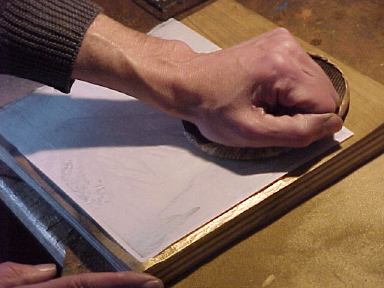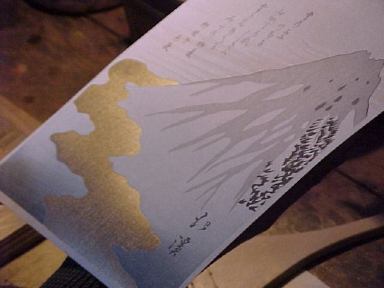Printing with Metal Powders
Metallic backgrounds
The 'surimono' prints that enjoyed a heyday in Japan in the late 1700's and early 1800's were noted for their use of 'special' printing effects. A printing technique commonly seen on fine surimono is the use of powdered metals: gold, silver, copper, bronze ...
Printing effectively with metals is a difficult job; they do not lend themselves to the same techniques used for the other pigments on a print, which are usually dissolved in a liquid medium (water or glue) in order to be applied to the paper.
Here is an outline of a basic technique for printing powdered metal. The example used is the application of a fine bronze powder on a reproduction of a print by Totoya Hokkei.

The powder will be attached to the print with 'nikawa' (gelatine). The first step is to prepare a solution of gelatine in water. It is difficult to describe the 'recipe' for this, because the strength of the glue will be determined by such things as the fineness of the metal powder in question, and the heaviness of the paper, etc. I am using an extremely fine powder in this example, so mixed the glue rather thinly.
A dab of the glue goes on the block. It should be mentioned that before the metal printing you are watching here started, the same block was used to print an 'undertone'. The most common colours for these undertones are grey to go under 'silver' type metals, and yellow to go under 'gold' type metals. Doing this ensures a deep rich effect in the finished print. The original print I am reproducing here uses a deep green tone under the bronze, and I printed that with the same block you see here being used for the metal itself. (By the way, the block in this photo looks to be covered in the metal powder, but that is because this photo was taken after many impressions had been taken. The 'dabber' in the photo is applying nothing but the gelatine mix ...)

Use a normal printing brush to spread the glue mixture out evenly over the surface of the block.

Lay the paper in place ...

And with light pressure, print the glue onto the surface of the paper. (Do not drive the glue down deep into the paper - the idea is to get a layer of glue right on the paper surface.)

Lay the sheet aside. Now moving quickly, before the glue has a chance to set, put a dab of bronze powder onto the block.

Use a very light brush, and gently spread it over the surface of the wood. A bird feather is sometimes used for this step. Getting it right is difficult - brush too firmly and not enough powder will remain - brush too lightly and the powder will not lie in a smooth layer. Ensure that the entire surface of the carved area is covered. A sheet of plain paper is tucked under the edge of the block to catch excess powder being brushed off ...

Put the paper back on the block ...

And again, rub the back to make the impression. Just how firmly to rub will depend on a number of factors; a bit of experience will show you ...

Peel off the paper, and you're done! Now, quickly get to work on the next copy before the left-over stuff on the block gets too gummy ...

Before coming to Japan many years ago, I had been worried that I would find that the old woodblock print craftsmen would be quite secretive about their work. I expected that it would be difficult for me to learn many of the techniques of woodblock printmaking, because I was an 'outsider'.
As it turned out, my fears were generally groundless. They readily answered my questions, and seemed quite willing to show me anything. As the years went by and I developed better ability with the language, making communication easier, I started to ask more complicated questions and ran into a bit of a different situation. It wasn't that they stopped telling me things, it was that the things I was asking weren't easily explained in 'so many words'. Learning many of the older techniques became not so much a matter of 'asking and listening', but of watching and doing ...
But it would not be the whole truth to leave it at that. In recent years, perhaps as a result of my own increased skills, I have run into a few cases where the person I was talking to obviously did not want to cooperate with my request. Some of the older men are quite proud of their skills, some of which were learned from masters a great many years ago. There are very few people now left with such skills, and these men in consequence feel a bit as though they are custodians of a sort of 'treasure'. Some of these men, not all by any means, do not easily share these treasures ...
I specifically had trouble learning the techniques of printing with metals. Nobody would say 'no' right to my face, but each time I brought up the topic, the conversation would slide away in a different direction, and we would somehow find ourselves talking about yesterday's sumo match ...
I persevered though, and through a mix of my own experiments, watching others carefully whenever I got the chance, and some help from one of the older printers who grudgingly 'gave in' one afternoon and let me into his workroom for a very short demonstration, have arrived at the stage where I can now reproduce what I see in the old surimono prints.
If you have just finished reading this tutorial, you may be asking yourself, "Well, so what? That was pretty simple. This is a 'secret' lost art that took David decades to uncover?"
Well ... I'm not sure how to answer your question. Reading through the description on that previous page, yes, I have to admit that it does seem pretty simple. But reading and doing are two very different animals; printing one little test sample is perhaps not too difficult - printing a run of 200+ consistent copies is something of a different story.
In this Encyclopedia I have freely given of whatever I have learned over the years, but as I get a bit older, I am more and more coming to understand something of the viewpoint of the older men here. Would you like to know 'how I do it'? Sure, here you go. But knowledge given that way is actually nearly worthless. Doing 200 copies of the bronze powder on that Hokkei reproduction called on nearly everything I have learned about printing over the last 20 years - the ability to sense tiny differences in the moisture of the paper and how to adjust the baren pressure as a result ... the ability to deal with the brush when the gelatine started to thicken as I went along ... just what to do when a certain 'patchy' appearance started to develop in one area of the impression ... Dozens of times during the course of that long day, I was faced with a problem that one thing and only one thing could solve - my long years of experience.
I also have to admit to a little bit of 'playing around' with that little photo essay. You may have noticed that although the woodblock itself is shown clearly in each photo, you can't see my workbench, or the tools and supplies ...
What's that, you want to know a bit more about the gelatine mixture? Whaddya think ... will those Yankees be able to repeat this year?

